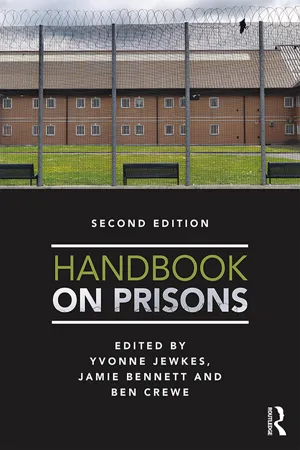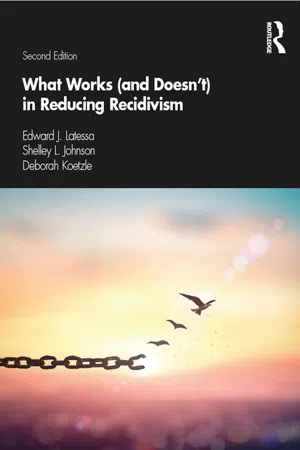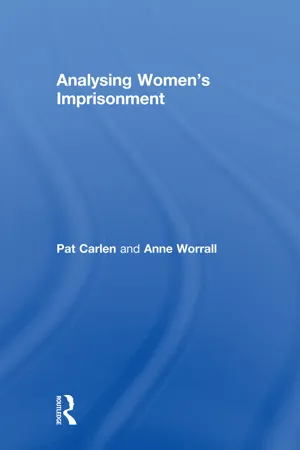History
Prison Reform
Prison reform refers to efforts to improve the conditions and effectiveness of the prison system. Throughout history, various movements and initiatives have aimed to address issues such as overcrowding, rehabilitation, and the treatment of prisoners. These reforms have often been driven by concerns about human rights, social justice, and the potential for rehabilitation and reintegration of offenders into society.
Written by Perlego with AI-assistance
Related key terms
Related key terms
1 of 4
Related key terms
1 of 3
9 Key excerpts on "Prison Reform"
- eBook - ePub
- Yvonne Jewkes, Ben Crewe, Jamie Bennett(Authors)
- 2016(Publication Date)
- Routledge(Publisher)
Sometimes ex-prisoners can play an important role in creating fresh thinking about the role of imprisonment. Winston Churchill was held captive briefly in a Boer prison and Nelson Mandela spent more than a quarter of a century in custody. While their African experiences were dramatically different, each offered an informed and compassionate voice to the debate about penal reform. Academic commentators, often drawn from the swelling ranks of professional criminologists, sometimes contribute their perspectives in various public forums.Penal reform bodies also have something to contribute to the debate about aims. The preamble to the 1787 constitution of the Philadelphia Society for Alleviating the Miseries of Public Prisons, which remains in existence as the Pennsylvania Prison Society, set out a number of underlying principles (Anonymous 1987 : 1–2), which when read from a distance of almost 230 years, are seen to have lost little of their cogency, even if they have faded from view in many policy contexts. They stress the common humanity of those who find themselves on either side of the law. They express a deep scepticism about the effects of harsh punishment and offer an optimistic view of the human capacity to change direction. They are strongly echoed in the 1870 principles that open this chapter, and are heard more faintly today. These principles are:- Prisons are ‘public’ institutions and the public should be concerned about their objectives and their effectiveness.
- Criminals are human beings and not made less so by the commission of crimes.
- It is legitimate to punish those who commit crimes.
- Harsh and degrading treatment tends to increase crime.
- Ways of turning law breakers into law-abiding citizens can be found.
- Society benefits from a system that ‘reforms’ criminals.
In addition to prisoners, policymakers, victims and reformers of various hues, there is another group that seeks to play a role in determining the aims of imprisonment. This comprises the shareholders in companies that build and manage prisons. In some jurisdictions they are becoming influential. - eBook - ePub
- Mathieu Deflem(Author)
- 2019(Publication Date)
- Wiley-Blackwell(Publisher)
Part V Punishment and Prison 20 History of the Prison Ashley T. Rubin Punishment scholars have traditionally divided penal history into a series of discrete periods. These periods are typically associated with either optimistic reforms encouraging prisoners’ rehabilitation in one way or another or pessimistic reforms abandoning rehabilitation and favoring some combination of incapacitation, deterrence, and retribution (but see Goodman et al., 2017). Each period is also associated with the rise of a particular “template” for prison – a new, replicable model of prison that spreads across the country as states copy the original (Rubin, N.D.c). Recently, however, scholars have challenged the nature of these periodizations, arguing for greater nuance and accuracy in how penal change is described over time (Campbell & Schoenfeld, 2013 ; Goodman et al., 2017 ; Rubin, N.D.c). Rather than periodizing US prison history, this chapter describes it as a series of overlapping periods of diffusion in which a particular prison template spreads across the country. This approach resolves several problems recently pointed out with the traditional stark periodizations (Goodman et al., 2017). First, it reminds us that penal change is not instantaneous, but a process that takes time – the period between the creation of a prison template and the final state that copies it can be 50 years or more; this would cover two or three periods in traditional periodization‐based histories. Second, and relatedly, it breaks the assumed relationship between the dominance of a particular prison template and a historical era (e.g., the Jacksonian Era or the Progressive Era). While reformers and prison administrators may create a prison template at the height of a particular historical era, the template might not become dominant until several decades later, when the historical era is waning or a new era has begun - John Muncie, David Wilson(Authors)
- 2013(Publication Date)
- Routledge-Cavendish(Publisher)
First, it focuses on recent debates concerning prisons in England and Wales through comparing and contrasting penal policy under successive Conservative Governments with that of the New Labour Government. Secondly, it considers how writers from different theoretical traditions have explained policy changes in England, Wales and the USA. Finally, it focuses on the debate between reformers and abolitionists, a debate which is central to thinking about the future of a system which, in England and Wales in the financial year 2002–03, cost over £2.2 billion to operate. Key Terms Rehabilitation; deterrence; incapacitation; ‘prison works’; the working prison; continuities and discontinuities; liberalism; reform; partnerships and ‘joined-up government’; social divisions; prisons and social order; gender and punishment; negative reform; abolitionism. From Rehabilitation To Punishment Since its emergence in the late 18th century, the modern prison has fulfilled a number of publicly—specified, overt roles including incapacitation, punishment, deterrence, reform and rehabilitation. These often contradictory goals have sat uneasily together for the last 200 years. Alternatively, at different moments during this period, one or more of these goals has taken precedence over the others. Thus, during the 1950s and 1960s, rehabilitation (at least in theory) was emphasised. This goal was built on the idea that the prison could change the behaviour of the offender through a series of professional and policy interventions designed, in the words of the 1964 Prison Rules, ‘to establish in [offenders] the will to lead a good and useful life on discharge, and to fit them to do so’ (cited in Fitzgerald and Sim, 1982: 25). From the mid-1970s, critics from the left and the right attacked the rehabilitative ideal. For the former group, the rhetoric of rehabilitation justified unacceptable interventions into the lives of prisoners, often by non—accountable professionals- eBook - ePub
Beyond the Walls of Separation
Christian Faith and Ministry in Prison
- Tobias Brandner(Author)
- 2013(Publication Date)
- Cascade Books(Publisher)
However, one internal factor must be considered as well. An inherent flaw of the penitentiary system was that, when offenders were restricted to their cells, conversion did not happen voluntarily, and it turned into coercion. Punishment, in the penitentiary system, preceded the expected repentance instead of flowing out of it as a voluntary act of penance. This flaw has, ever since, been a challenge for all penal models that emphasize rehabilitation. Eventually, when success in rehabilitation failed to appear, when prisoners instead of repenting became ever more hardened and desperate, when penal bureaucrats who lacked religious or ethical concern for the rehabilitation of the inmates replaced the early reformers, and when the belief in the reformability of criminal offenders waned, only the physical shell of the penitentiary remained: solitude in the isolation of individual cells and hard labor. Many present-day prisons remain as silent witnesses of this early belief in transformation through coerced repentance. Prisoner Rehabilitation in the TWENTIETH Century Although the ideal of the prison penitentiary failed, the idea of reformation or rehabilitation survived. Ever since the nineteenth century, prison punishment, while maintaining a deterrent and a punitive element, was also designed to reform or reeducate the criminal offender. This principle has been widely adopted and has entered judicial and penal contexts beyond the Western and Anglo-American context, even though sometimes in tragically perverted forms such as reeducation through labor, applied by totalitarian governments both in East and West. In practice, the fragile idea of rehabilitation was always threatened by popularly more appealing penal ideologies that emphasize deterrence and retribution, and was always undermined by the reality of overcrowded prisons - eBook - ePub
The Reform of Prisoners
1830-1900
- Willam James Forsythe(Author)
- 2020(Publication Date)
- Routledge(Publisher)
7From the early period of John Howard all reformists were struck by the probability that within prisons as they were constituted at the end of the eighteenth century there existed very powerful influences which operated to prevent the reconstitution of attitude and belief which they sought. In particular writers increasingly pointed to the unrestrained intercommunication between prisoners which occurred in unreformed prisons because they believed that, left to their own devices behind the walls of a prison, prisoners would divert each other from reform. They would glorify the stumbling blocks which prevented the flow of God’s grace such as drinking, gaming and sexual adventures, and would either teach each other criminal skills or at least reinforce criminal attitudes by encouraging or rewarding the exhibition of defiance, hardihood and contempt towards God and law. This anxiety began to be expressed during the late-eighteenth century; the pious reformist London merchant Jonas Hanway frequently emphasised the corruption which occurred in prisons.8 The early-nineteenth century prison explorer James Neild excoriated the promiscuous association, drunkenness and vice in prisons which ‘disqualify the mind for the humiliation consonant to the place’9 and a London physician commented that in Newgate the prisoners ‘may get drunk when they please’.10 - eBook - ePub
- Francis Cullen, Karen Gilbert(Authors)
- 2012(Publication Date)
- Routledge(Publisher)
38 The prison, of course, presented an ideal locale in which to pioneer this new reformative society.The most urgent task confronting reformers was to restructure the internal routine of the penitentiary so that it would affirm the principles that had made for an orderly society in colonial times. It was clear that offenders would have to experience the discipline absent in their defective upbringing. Respect for authority would be mandated, and obedience to unbending rules demanded. Idleness, an inevitable occasion for vice and mischief, would be replaced by hard and steady labor aimed at instilling good habits that inmates could carry with them upon release. The value of religion would similarly be emphasized, with all offenders being amply educated in Christian doctrines. And above all, inmates would be totally separated from contacts that might result in their further contamination and commitment to criminal ways. The prison must not degenerate into a school for knavery and licentiousness.Two competing reform movements emerged, each trumpeting a distinct program for how the core principles of an orderly society of captives could best be satisfied. As might be expected, the Quakers and other liberal elements in Pennsylvania combined to form one of the groups at the forefront of this quest to establish a truly rehabilitative institution. Learning from their dismal failure at the Walnut Street Jail, these reformers were adamant that freedom from debasing criminal interactions could only be attained through a system of total solitary confinement that was never to be compromised. They proposed that each inmate be housed in a separate cell, day and night, for the entire term of incarceration. No communication with either fellow captives or outside visitors would be permitted. Even contact with guards and prison authorities was to be kept to a bare minimum. Inmates would be compelled to work alone in their cells at such tasks as spinning or shoemaking. The Bible was to be the only reading material that would be made available, and it was anticipated that its teachings would facilitate the process of penitence as offenders reflected upon their errant ways in the loneliness of their cells. - eBook - ePub
- Edward J. Latessa, Shelley L. Johnson, Deborah Koetzle(Authors)
- 2020(Publication Date)
- Routledge(Publisher)
www.archives.nysed.gov/a/research/res_topics_ed_reform_history.shtml .In the end, none of these systems proved to be very successful. Overcrowding, a lack of funding, and abuse were rampant (Conley, 1980). As such, a new set of reforms began to take root. The new reformers argued that prisons should be designed according to the purpose of rehabilitation and eventual release. The Declaration of Principles was adopted by the National Prison Association in 1870 with this philosophy in mind.The principles included the following:• Punishment should be for reformation.• Reforming the individual helps protect society.• Prisoners should gradually progress through the system and receive marks for good behavior (including rewards).• Special training is required for prison officers.• Education and religion are important areas that should be addressed.Visit the following website for more information: www.aca.org/pastpresentfuture/principles.asp . The principles represented a departure from previous policies that were focused primarily on punishment via the deterrence philosophy.One institution that attempted to adopt these principles was the Elmira Reformatory. The reformatory, which opened in 1876, was designed for first-time felons aged 16–30 years. It had a system composed of three levels of classification. Those incarcerated would begin at Level 2 and had to progress to Level 1 in order to gain release. However, they could be demoted to Level 3 for poor behavior. In order to move from Level 2 to Level 1, inmates were required to follow the rules, attend school, and work for a period of at least six months. However, if they refused to follow the rules, the inmates were moved from Level 2 to Level 3. At that point, residents would be required to exhibit positive behavior for at least three months before they could progress to Level 2 and start the process over again (Pisciotta, 1994). - eBook - ePub
- Pat Carlen, Anne Worrall(Authors)
- 2013(Publication Date)
- Willan(Publisher)
In pure form they are usually listed under the headings of: retribution, reform, rehabilitation, social protection, deterrence (individual and general) and expiation. Chapter 4 provides fuller definitions and discussion of these justifications for imprisonment, though, for the reasons just discussed, they are nowadays seldom operationalised in pure form. The modernisers’ emphasis on discipline had the ideological advantage of sidestepping questions of punishment and legitimacy by giving primacy to a prison and prisoner disciplinary mode of regulation seen to be equally desirable for all citizens, all social institutions and, indeed, for society as a whole. The postmodernist emphasis on the reconfigurability of all disciplines to meet multiple but differentiated ‘need’ provided more of the same but with a difference. All of the dominant ideological reconfigurations of official penal discourse over the last 400 years, have, in different ways, managed to avoid the question ‘What are prisons for ?’ Foucault’s disciplinary thesis The main concept to be used in this section on the modernisers is that of ‘ discipline ’, taken from a work which has achieved a prominence beyond all others in the modern sociology of punishment: Discipline and Punish, by the French philosopher Michel Foucault, first published in 1975 in French and translated into English in 1977 - eBook - ePub
Foucault - The Key Ideas
Foucault on philosophy, power, and the sociology of knowledge: a concise introduction
- Paul Oliver(Author)
- 2010(Publication Date)
- Teach Yourself(Publisher)
It is interesting to reflect upon the range of potential causes of the late eighteenth-century penal reforms. One might, for example, attribute the transition from a public and cruel execution to the disciplined, impersonal atmosphere of a modern prison, to a sense of moral outrage at conspicuous cruelty and torture. However, social change is invariably and inevitably complex, and it is usually almost impossible to specify with any accuracy the chain of causal events that lead from one social system to another. However, it is probably no accident that the penal reform movement coincided with the enormous economic changes of the industrial revolution. It has often been argued that the transformation of the educational system and the increased emphasis upon ensuring widespread numeracy and literacy was linked directly to the need to provide educated workers for the factories of the industrial revolution. If a country is to compete economically, then it needs an educated workforce to both design and develop technological innovation, and also to operate it once installed. This is an argument that governments have frequently made since the early nineteenth century.In a sense the same arguments applied to Prison Reform. If society was to function as an integrated whole, then the prison system had to take in people who were dysfunctional and transform them into people who could leave prison and become effective contributors to the economic system. The result was that the prison system had to develop strategies for educating and for socializing prisoners into the norms and values of a working life. It was imperative for the economy of the country that inmates left prison with both the skills and motivation to contribute to the country’s economy. These kind of sentiments undoubtedly pervaded the social and political planning of the period. We may not be able to point to a precise and linear causal connection, but there was undoubtedly a general sense that planning, structure and organization were required in society, if that society was to function efficiently in the modern world. Yet Foucault noted that ‘prison indirectly produces delinquents’ (Rabinow, The Foucault Reader , p. 229).InsightMany of the legal and judicial measures that developed in the modern era can be related to the nature of the developing industrial economy. The ideal punishment was one that enabled offenders to understand the positive features of working and contributing to the economy, and that also gave people the skills to enable them to participate in a capitalist economy.It is also perhaps interesting that, in the penal reforms, gradually much more attention was paid to crimes involving theft and other crimes against property and the possessions of people. This contrasted with the early eighteenth century when the crimes perceived as being the most serious were those that were a challenge in some way to the higher social classes of society. Ultimately, the most serious crime was one aimed at the monarchy. The late eighteenth century, however, saw the advent of a society that would become centrally preoccupied with material progress and with economic success. People were encouraged to work hard and to accumulate wealth. Any crime, therefore, that sought to misappropriate such wealth was regarded as very serious indeed, and the punishment commensurately severe.
Index pages curate the most relevant extracts from our library of academic textbooks. They’ve been created using an in-house natural language model (NLM), each adding context and meaning to key research topics.
Explore more topic indexes
Explore more topic indexes
1 of 6
Explore more topic indexes
1 of 4








